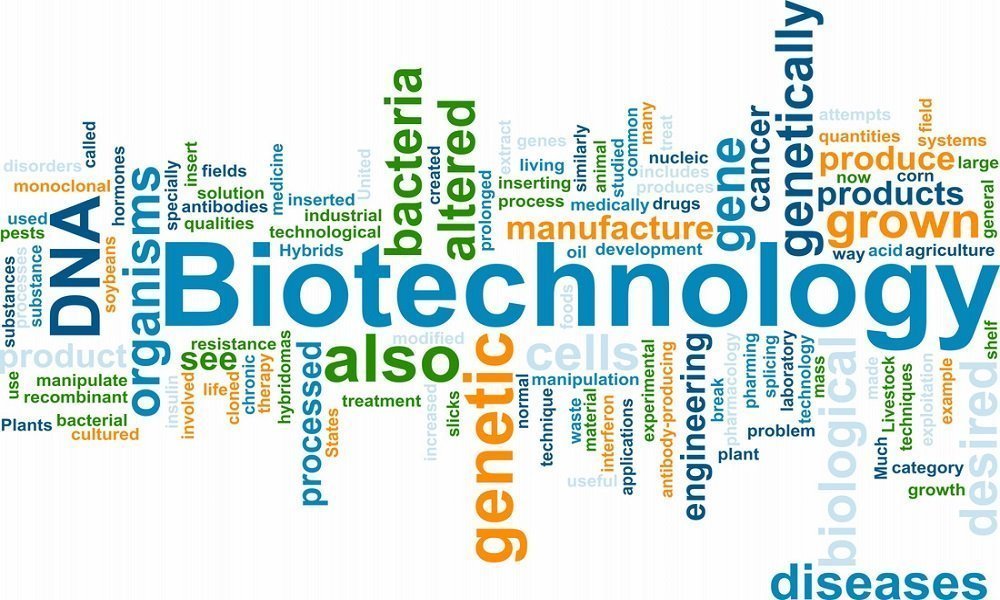The word biotechnology has come from two words, bios (meaning biology) and technology (meaning technological application). Thus biotechnology is defined as the industrial application of living organisms and their biological processes such as biochemistry, microbiology, and genetic engineering, in order to make best use of the microorganisms for the benefit of mankind.
Biotechnology is applied in many areas to produce foods and medicines, in the development of new diagnostic tools, gene therapy, and DNA finger-printing for forensic purposes.
Applications of Biotechnology
1. Health and medicine
Fighting infectious diseases: Biotechnology is used extensively in the study of infectious diseases such as SARS (Severe Acute Respiratory Syndrome), and influenza. As a result, more effective pharmaceuticals have been developed.
Development of vaccines and antibiotics: Using technology, microorganisms are used to develop antibiotics and vaccines to cure diseases. For example, bacteria Bacillus polymysea is used to produce polymyxin B (antibiotic used to cure urinary tract infections), fungus Penicillium notatum is used to produce penicillin (used to cure pneumonia and many other bacterial infections.)
Treating genetic disorders: Disease can occur when genes become defective due to mutations. With advancements in biotechnology, in the near future it will be possible to use gene therapy to replace an abnormal or faulty gene with a normal copy of the same gene. It may be used to treat ailments such as heart disease, inherited diseases such as SCID, and Thalassaemia.
In forensic science: A lot of New techniques have been developed such as DNA fingerprinting, besides having a number of other applications which have facilitated the speedy identification of the criminals.
2. Environment
Cleaning up and managing the environment: Cleaning up the environment using living organisms is called bioremediation. Naturally occurring, as well as genetically modified microorganisms, such as bacteria, fungi and enzymes are used to break down toxic and hazardous substances present in the environment.
3. Agriculture
Biotechnology has also made possible the production of crops improved disease resistan; herbicide-toleran and insecticide-resistan. Plants with improved nutritional value for livestock have also been obtained through biotechnology.
Control of pests: One application of biotechnology is in the control of insect pests. The genetic make-up of the pest is changed by causing some mutations. These pests become sterile and do not reproduce further.
Manufacturing and bio-processing: With the help of new biological techniques in Biology it has become possible to grow, the plants that produce compounds for use in detergents, paints, lubricants and plastics on large scale.
Food and drinks: Biotechnology, has also made the processing of foods and their products easier. Preservation and storing of food for consumption later has become easy and cheap with the help of biotechnology. Seedless grapes and seedless citrus fruits have been developed using biotechnology.
4. Industry
Biotechnology has been used in the industry to produce new products for human consumption. Food additives have been developed which help in the preservation of food. Microorganisms are used in the mass production of items such as cheese, yoghurt, and alcohol.
Industrial Microorganisms and Their Industrial Products
Important microorganisms used in industries include
- yeasts (fungi)
- moulds (fungi)
- bacteria
- filamentous bacteria (actinomycetes)
Microbes are used in the manufacture of several products. Some of these are
- alcohol-containing beverages
- yoghurt (curd)
- proteins
- antibiotics and monoclonal antibodies
- vitamins, steroids and enzymes
- biogas
The progress in gene manipulation and genetic engineering has introduced the use of cultured mammalian cells and ‘hybridomas’ in the industries. Hybridomas are created by fusion of cells belonging to organisms of different species.
Production of Alcohol-Containing Beverages
Fermentation
Fermentation is a process by which carbohydrates such as sugar are converted into alcohol.
Yeast is capable of fermenting sugar to alcohol. Fermentation is an energy yielding process.
In the mid-nineteenth century, Louis Pasteur showed that fermentation by the yeast Saccharomyces cerevisiae yields beer and buttermilk. Presently yeast is being used on a large scale for brewery and bakery.
Bakers use yeast to leaven (raise) dough to make bread. Yeast is also grown on molasses and is packed and sold. Yeast is used to raising cakes and bread while baking.
Alcoholic beverages are manufactured by fermentation of sugars by the yeast,
Saccharomyces cerevisiae. It is called Brewer’s yeast. The source of carbohydrate fermented by yeast gives the beverage its specific flavour. For example :

- Wine is obtained by fermentation of grapes. Grapes are fermented by S. cerevisiae and its soluble sugars (glucose and fructose) are converted into CO2 and ethyl alcohol.
- Fermentation is carried out in large tanks called bioreactors.
- Barley malt is fermented to yield beer
Steps taken for fermentation
- Fermenter or tank and the nutrient medium are sterilised by steam under pressure (autoclave).
- The correct strain of yeast is selected.
- The yeast is inoculated into the medium. Inoculation can be done in two ways:
(a) Yeast can be grown as a layer on the surface of nutrient medium. This is called support growth system.
(b) Cells or mycelia are suspended in a liquid medium. This is called suspended growth system. - Care is taken to maintain the right temperature, pH, oxygen and carbon-dioxide concentration.
- The medium is stirred and left to ferment.
- The sugar in the medium gets fermented by enzymes released by yeast.
- The fermented product is taken out.
Some alcohols manufactured by yeast fermentation are : Ethyl alcohol, butanol and glycerol. The same method also yields lactic acid and acetic acid (vinegar) by using
specific bacteria.
The yeast extract left after removal of the beverage can be used as animal feed. It is also a rich source of vitamins.






Leave a Reply
You must be logged in to post a comment.